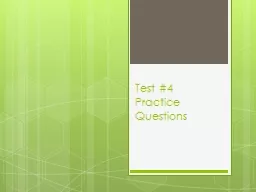

A 15yearold male is brought to the ER for treatment of injuries received in a motor vehicle accident An MRI reveals spinal cord injury and his body temperature fluctuates markedly The most accurate explanation of this phenomenon is that ID: 712057
Download Presentation The PPT/PDF document "Test #4 Practice Questions" is the property of its rightful owner. Permission is granted to download and print the materials on this web site for personal, non-commercial use only, and to display it on your personal computer provided you do not modify the materials and that you retain all copyright notices contained in the materials. By downloading content from our website, you accept the terms of this agreement.
Slide1
Test #4Practice QuestionsSlide2
A 15-year-old male is brought to the ER for treatment of injuries received in a motor vehicle accident. An MRI reveals spinal cord injury, and his body temperature fluctuates markedly. The most accurate explanation of this phenomenon is that:
He developed pneumonia
His sympathetic nervous system has been damaged, and thermal control disturbed
He has a brain injury
He has septicemia from an unknown sourceSlide3
His sympathetic nervous system has been damaged, and thermal control disturbedSlide4
A 72-year-old male demonstrates left-sided weakness of upper and lower extremities. The symptoms lasted 4 hours and resolved with no evidence of infarction. The patient most likely experienced a(n):
Stroke in evolution
Arteriovenous
malformation
Transient Ischemic Attack
Cerebral HemorrhageSlide5
Transient Ischemic AttackSlide6
While planning care for a patient who has acute
pyelonephritis, a
nurse recalls the most common condition associated with the development of acute pyelonephritis is:
Cystitis
Renal Cancer
Urinary Tract Obstruction
Nephrotic
SyndromeSlide7
Urinary Tract ObstructionSlide8
A 42-year-old male is involved in a motor vehicle accident during which he loses a lot of blood. The nurse realizes he is in acute renal failure caused by:
Kidney stones
Immune complex deposition in the glomerulus
Inadequate renal blood flow
Obstruction of the proximal tubuleSlide9
Inadequate renal blood flowSlide10
Which patient is most prone to multiple organ dysfunction syndrome (MODS)? In a patient with:
Myocardial infarction
Pulmonary disease
Septic shock
Autoimmune diseaseSlide11
Septic ShockSlide12
A 10-year-old male is given penicillin for an infection. He has an allergic reaction, during which he develops urticarial lesions. These lesions are mediated by the release of:
Beta-adrenergic agonists
Histamine
Calcium
CortisolSlide13
HistamineSlide14
A 28-year-old male is admitted to the burn unit 2 hours after receiving second- and third-degree burns over 50% of his body surface in an industrial explosion. Abnormal vital signs include low blood pressure and tachycardia. Lab results show a high hematocrit due to:
Sickle cell syndrome
Fluid movement out of the vascular space
Renal failure
Increased vascular protein secondary to increased metabolismSlide15
Fluid movement out of the vascular space